Leverage your transportation, logistics, and supply chain business capabilities with paperless documentation
This article introduces the broader issues of document digitization in international logistics, freight transport, and the supply chain as a whole. We're keeping up with the latest developments in document digitization. It is clear for us that the dominant approach in transportation, or logistics is highly focused on integrating existing systems. We're not going to beat around the bushes because our goal is to provide you essential information that can help you shift your way of thinking about document flow. So, let's move together and take a look at how you can increase your business capabilities with digital document flow in the entire supply chain landscape.
Document digitization foundations
If you want to operate in the transportation industry successfully, it is essential to understand that this is one of the main ingredients of the supply chain. There are strong links between transportation and Supply Chain Management (SCM) and logistics. Therefore, good observation of all the touchpoints in the supply chain process will help improve the ongoing transportation processes.
This boils down to the segmentation of the transport industry, the success of which largely depends on the documents flow and its close connection to supply chain operations. Here on the stage comes various transport and logistics documents that can be handled in the best way once they are available in digital format. But it is more complex, while most transport and logistics documents, or various contracts are still paper printed. If you want to step into digital transformation effectively, your business requires document scanning software. Before we tell you more about document digitization daily, it's good to start with the actual foundation of goods transport and document flow in the supply chain.
Here are the main transportation segments and document management
Talking about document digitization, we briefly examine the relative significance of various modes of supply chain transport and their impact on the flow of transportation and logistics documents. There is no doubt that this is the area where the seamless movement of documents plays a crucial role. We now have several segments of transportation that are crucial for domestic economies and are vital to keep flexibility across various supply chain channels:
Maritime transport
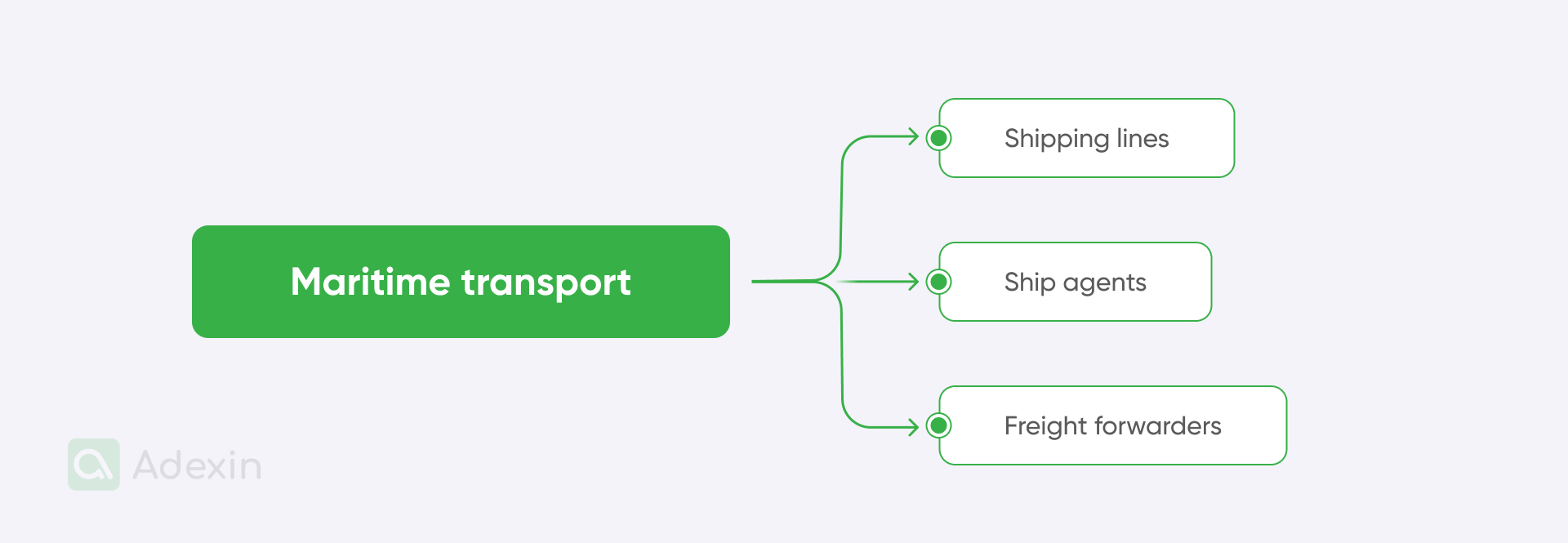
Documents in maritime depend on three parties. Each party creates a document source that helps control the transport through the sea, ocean, and even freight transport on inland waterways, such as rivers or canals. These parties are:
Shipping lines
Shipping lines are the owners and operators of the various types of vessels in their fleets. Their primary role is to provide the physical resources necessary to transport cargo safely and efficiently by waterways. It's very possible that you're already dealing with them in your daily communication and have already received several emails with outstanding PDF documents, such as certificate of origin (COO), waybills and others.
Ship agents
Ship agents offer essential services to shipping lines in ports of call. These agents perform a wide range of critical tasks for the supply chain on behalf of the shipping lines, which also involve handling crucial documents. They might be interested in custom procedures, feeding your Operations Support Group department with Customs documents and invoices.
Freight forwarders
Freight forwarders, also known as transport management companies, oversee the entire freight journey from start to end. They provide end-to-end solutions for the supply chain. They handle documents, coordinate modes of transport, manage customs processes, and organize port services. They may help you connect more than one way of shipping goods and will provide you with tons of various shipping documents.
Need custom freight management solution?
We are happy to help you
Explore moreAn excellent example of maritime transport is all that happens in the Port of Antwerp-Bruges in Belgium, one of the largest in Europe. This port unquestionably handles a large number of container shipments via vessels that are shipped through the various waterways. The Port of Antwerp-Bruges in Belgium is also an excellent example of supply chain models that underpin logistics shipping operations worldwide. These shipping operations generate a substantial volume of documents, often transmitted from one vessel to other ports and vice versa, by using typical USB memory sticks passed among seafarers. [1]
So, at this point, there's a significant reliance on digital documents stored on these types of hardware, but maritime transport often still relies on paper documents. What directly helps in handling this process are document management system solutions, especially those dedicated to transportation. Summarizing this paragraph, we can conclude that no matter which transport mode you choose within your supply chain, with DMS software, you'll have all-in-one access to your transportation documents in one place. You can also minimize the risk of document loss by passing them in paper format, as is mentioned only on USB memory sticks.
Air transport

Opposite to maritime transport, air freight involves distinctly different legal regulations based on the various types of aircraft, from airplanes to helicopters, each requiring specific documents. Most of today's regulations are overseen by the International Air Transport Association (IATA), which also enforces strict laws regarding the transportation of dangerous goods (DGR). Similar to maritime transport, air freight involves three major parties in the document flow that need to be exchanged among supply chain stakeholders:
Airlines
In the case of airlines, it's about companies that own and operate aircraft for passenger and cargo transport. They specialize in services such as low-cost supply chain operations or air freight. This specialization also gives rise to a multitude of documents exchanged between ground personnel at the airport and beyond. Eventually, these documents, such as Bills of Lading, can end up on your desk in your warehouse. Everything is highly interconnected.
Cargo agents
Cargo agents, licensed by IATA, handle airfreight on behalf of clients. They must comply with IATA standards, maintain insurance, and issue airway bills (HAWBs) and other transport and logistics documents. The challenge with IATA regulations is that they change annually. Your personnel need to stay updated to avoid mistakes on documents, often requiring them to check the 1,000-page IATA regulation book necessary for labeling shipments. Simply put, air freight shipments entail a multitude of documents, which pass from hand to hand throughout the supply chain operation cycle.
Airport authorities
Airport authorities are the owners and operators of airport infrastructure, which also involves a substantial volume of documents that must be provided to air carriers. These documents include information on how cargo is stored before it is loaded onto an aircraft. Logistics personnel on the ground need to know what they are dealing with before loading cargo and what to do once the shipment arrives at its destination airport.
Regarding air freight, the quality of service must be the highest priority. It's all about avoiding compliance with transportation rules. Therefore, it is crucial to provide the highest quality of documents when they pass from one party to another, especially for hazardous cargo (DGR). To prevent plane crashes like the case of UPS Airlines Flight 6 on September 3, 2010, caused by an onboard fire, it's evident that exchanging high-quality documents among key parties in supply chain and logistics is essential for ensuring cargo and people safety. [2]
The world's largest airports, such as Denver International Airport (DEN), handle approximately 235,611 metric tons per year, directly highlighting the significance of a streamlined digital document flow. This is a huge amount of paperwork for logistics personnel that operate in warehouses on airport premises or coordinate deliveries from outside locations. The solution to these challenges lies in professional digital document quality management software, which unquestionably secures the entire document flow with high-quality data. This solution is not exclusive to air freight; good quality DMS software can be applied in any industry where top-quality data on shipments is essential to avoid costly issues.
Rail and intermodal transport
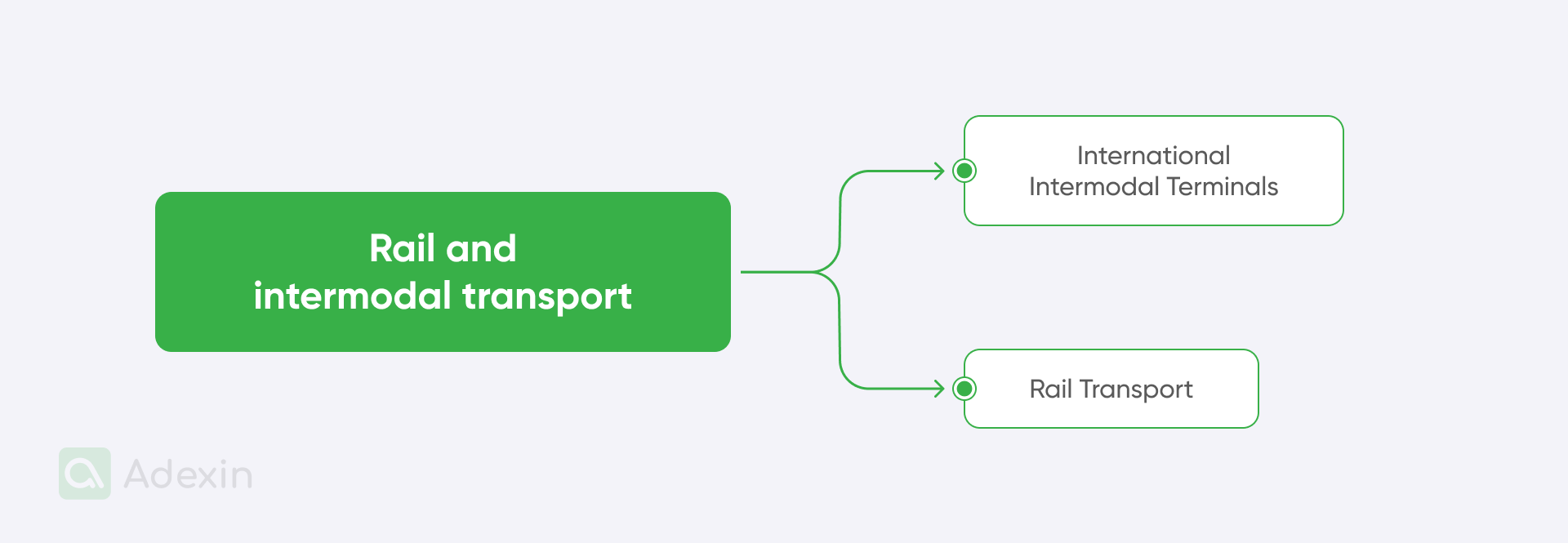
Rail transport for the cargo combines different intermodal equipment that is selected regarding cargo requirements. There are a variety of independent standard documents that can be used directly for transportation purposes, and the type of modal transport can provide a basis for drawing up a new record. Most of the shipments for this transport are handled in containers or by trailers, which are later replaced on the trucks in the road transport. All that depends on supply chain planning. Here are two elements that are important for this kind of transport. These are included as follows:
International Intermodal Terminals
These are key road-rail interchange points within the rail industry dedicated to cargo. They often include warehouses, distribution companies, and consolidation services for general cargo and freight. This forms an interconnected network coordinated by supply chain operations. Documents flow significantly as these terminals are connected to ports and road freight, resulting in various documents for various transport purposes.
Rail Transport
Carriers that provide rail transport utilize public rail infrastructure for various transport modes and cargo available through the supply chain. This includes cargo in enclosed boxcars, refrigerated wagons, flat wagons, tankers, containers, and car transporters. Various documents come into play, specifically for stakeholders closely associated with ground freight.
Rail transportation plays a significant role in domestic economies, and in various scenarios, rail and intermodal transport offer the most efficient means of handling shipments. As intermodal transport combines both road and rail transport, this presents a significant logistics challenge. A great example is the European rail network via the Channel Tunnel. This kind of model requires a wide range of shipping and customs documents.
There's no doubt that digitizing document flow in rail transportation, using shipping documents digitalization software, can effectively remove the constraints associated with this form of transport in the supply chain. It is important to remember that this solution isn't exclusive only to rail and intermodal transportation. It has been successfully deployed in various types of transport widely used for the entire supply chain, supporting shipping operations in many cases, such as road transport.
Road freight transport
This form of freight transportation is the most popular, mainly because it is the final stage of handling shipments before they reach their destination in warehouses or distribution centers. Of course, road transport with truck and trailers go far beyond and is the core element of the supply chain. Road transportation of goods includes a variety of shipping operations dependent from logistics, with trucks and trailers as the main types of vehicles. These vehicles can transport cargo from airports and ports, carry raw materials from mines, deliver windmills to power plants, and much more. The range of shipment is highly diverse, with no limits.

Nevertheless, shippers and carriers must efficiently manage documentation tailored to the specific cargo being transported. There are three specific elements that can affect the required documents in road transportation:
Main types of vehicle body
Choosing the right vehicle body type depends on operational and load requirements. Different body types offer unique advantages and disadvantages based on the tasks and cargo resulting from planning in the supply chain. They may also require unique documents and approvals to participate in road traffic regarding large-volume goods to transport.
Types of operation
The broad spectrum of supply chain operations matches a wide range of tasks, such as long-distance transportation involving fast delivery of heavy loads. Road trucks with multiple trailers are very common in some cases as a solution for the supply chain. Drawbar combinations offer additional cargo space for light but bulky loads. Special trailers handle medium-weight and volume loads.
Load types and characteristics
Cargo characteristics are crucial to transportation planning, where the first stage is shipping from the logistics warehouse. A shipment may contain light or bulky cargo that requires vehicles with high volume relative to their weight. Heavy loads require specialized vehicles, and mixed loads present weight distribution challenges. Valuable cargo requires secure vehicles with anti-theft features.
Besides the aforementioned characteristics of consignments, there are also other ones, such as bulk liquids and powders, which require specialized tankers. These are mostly dangerous goods that require extra precautions to prevent chemical reactions and electrical hazards. As we've previously mentioned, in the context of air freight transport, supply chain planning must comply with transportation law, resulting in a substantial volume of documents.
There is no single example to illustrate the types of documents required in transportation and logistics, but all of them should be digitized. Adopting a Document Management System (DMS) for transportation and supply chain operations can revolutionize your business and how documents are handled.
You can also support your truck fleet by providing real-time assistance on the road, offering all the data to your personnel whenever they need it. Digitizing documents can help you push the boundaries of your business beyond the typical problems associated with paperwork.
Why to start with document digitization?
With this knowledge, we can explain why you actually need digital documents in transportation, logistics or supply chain all together. We can help you transform your business structures into a more reliable environment. Since many companies are currently undergoing a digital transformation, you can expect that your company will need to do the same.
This will happen sooner rather than later, as it is clear that more significant partners in the supply chain are already using digital document handling systems with mobile devices for basic confirmations such as proof of delivery (POD). And you will have to meet their requirements.
However, this is not the only reason. First of all, you need to satisfy your customers, that are the most important in the supply chain planning. So, it is highly likely that they require access to mobile software for PODs and more. Each document may require a virtual signature. This is telling us, why you will need to implement this feature along with transport document management. These requirements are critical for last-mile deliveries, but virtual signatures may also be required to approve various shipping documents or carriers' contracts. This becomes a major challenge when a company has growth ambitions.
There are also other features that your truck drivers may need, but in this case, you really need to evaluate the complexity of your business. Then, you can take a bold step toward document digitization for your transportation and supply chain operations.
Problems with paper documents in transportation
You may have faced some of the paperwork problems in your transport and logistics operations. We listed some of them to highlight the most significant pain points for the transport industry.
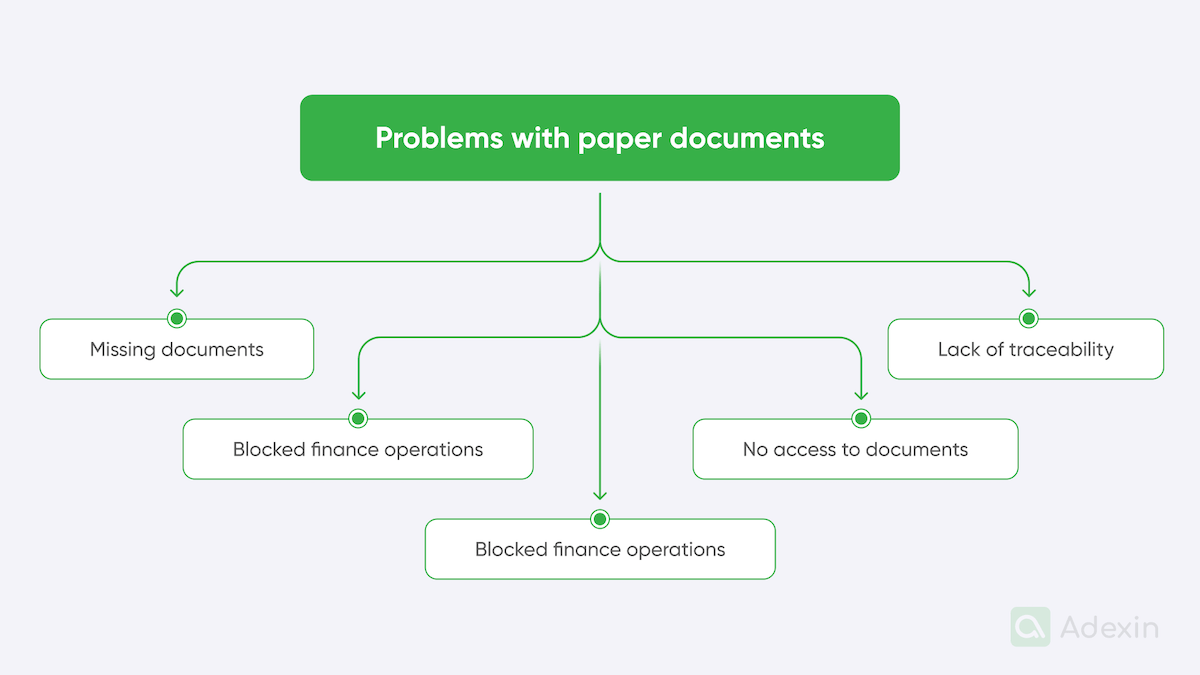
Missing documents
What makes work in transportation and supply chain oppressively difficult are the missed, mixed, or switched shipping documents on the pallets. Hours pass before your team can process the shipment for the warehouse stock.
This is not the sole reason, but regardless of the cause of missing paperwork. In the end, everything comes back to transport administrators, who must provide document copies via email or reprint them.
Unreadable documents
Unfolding other challenges in transportation and supply chain, we bring into closer focus issues related to the readability of transportation documents.
How often have you seen this growing frustration when your people cannot read documents or need to rewrite data from them manually, yet they are obliged to provide fast feedback because trailers are waiting for unloading at the logistics warehouse?
Blocked finance operations
Smooth financial document flow in transportation and supply chain shortens the time to invoice. The document cycle in transport requires various confirmations, from freight invoices to ocean freight documents. The range of papers is extensive, especially about international shipping. You need them on time to get paid.
Lack of traceability
Everyday issues in logistics and supply chain are related to the lack of traceability. This results in missing packages. In many cases, it also resulted in lost pallets, which were unloaded in the wrong warehouse and ultimately led to lower customer satisfaction. Most of these problems happen when truck drivers don't have the right tools.
No access to documents
The major problem in today's document management for supply chain is caused by poorly located sources of information. Low access to the documents or lack of fast data exchange capabilities for documents often don't allow the shipping process to move forward. Your business is frozen, and it costs a lot of money.
Starting with document digitization in transportation
What is the basis of document digitization? Yes, you need software, but this software has its most important feature that allows you to quickly transform your paperwork into digital assets that can be freely exchanged throughout the company's departments. We're talking here about optical character recognition (OCR) for your transportation documents.
This basic feature can use a camera to recognize pieces of text and convert them into a digital format. Simple as it is, but you may need great software developers to help you make it real, or you can just use some existing system to handle documents. This is how you can make a choice between custom software development and an off-the-shelf solution.
In many exceptions, it is easy to say, let's use something that is already on the market and has its users. But it often boils down to higher expenses and, more often, double work. What we're talking about here is that off-the-shelf software might be easy to access, maybe a bit cheaper but in most cases, it will not cover your complex business needs.
As we mentioned above, you may need OCR functionality, POD, and virtual signature embedded as a feature of your document management system. However, off-the-shelf solutions will have simple integration problems, as virtual signature features may be missing. So your customer will not get all the data in one place. Your truck drivers will not be able to scan documents and share them with you when it's needed. That was just one of the many examples of how your life can get more complex with no custom development.
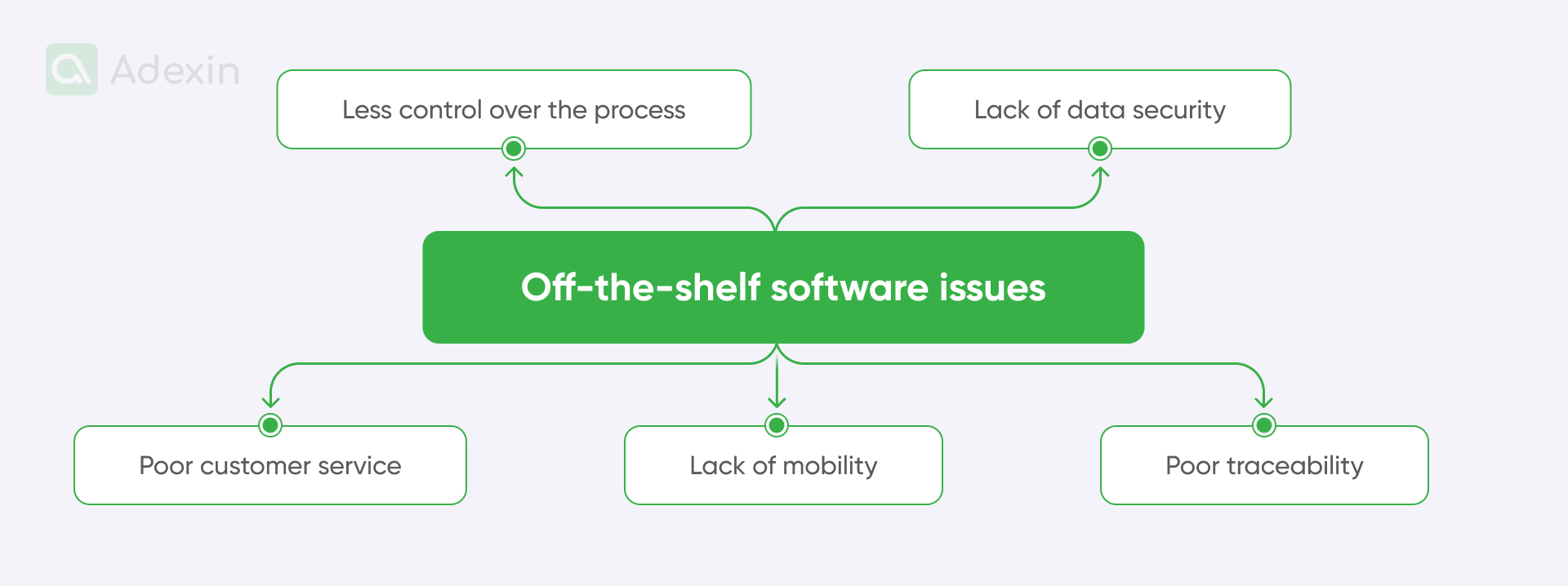
Off-the-shelf solutions can reveal many problems:
Less control over the process
Poor customer service when it comes to handling issues
Lack of data security (you never know who manages your sensitive data)
Lack of mobility (most of the services don't provide mobile apps)
Poor traceability
What you really need before starting with document digitization in transportation and supply chain is to find experts who understand the industry from the field of software development. They will know how to integrate DMS with the right features and connect it to your existing system. Yes, that's true. Document digitization systems can be just an additional functionality to your existing systems, so you don't need to rebuild your organization and bring chaos to operations. With custom software development, you can transform your business step by step, ensuring sustainable growth.
Need help with document management systems development?
Learn how we can help you
Explore moreDocument digitization software features

When you've already decided to consider professional document digitization software, it's worth knowing what kinds of features you can find. We have selected some of them right here to help you understand their value. These can turn into real gold in each industry, whether it's supply chain, logistics, transportation, or other side operations such as financials, administration, or people management.
Feature | Description |
|---|---|
Of course, there are many features, and you may not need all of them at once. It all depends on your business operations requirements. We have selected 5 key features of paper document scanning software to make it even easier to help you make the right choice. You can always reach out to us and learn about scanning software and document management in various industries.
6 ultimate benefits for transportation
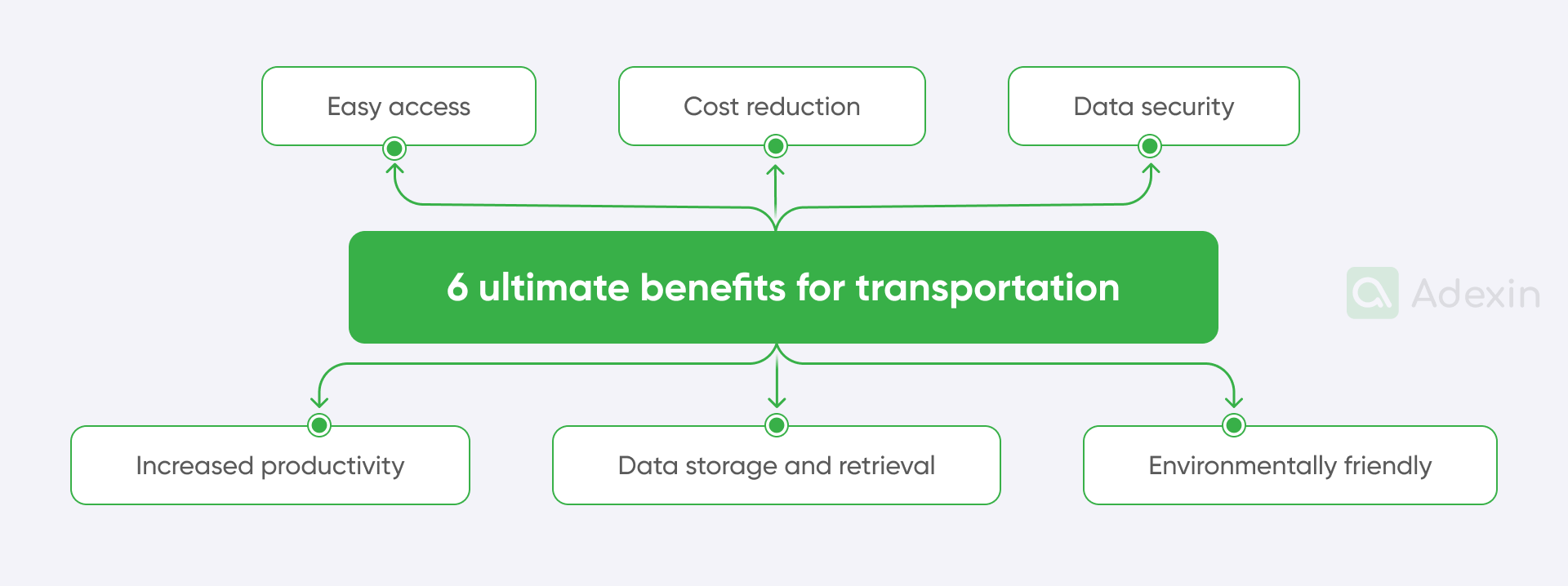
Document digitization provides great benefits to a company that can simplify transportation, logistics and supply chain operations. So, you can consider much easier what is actually relevant and added value to your transportation business. Here are these benefits:
1. Easy access
Easy access to critical documents is crucial no matter which industry you’re in . Digital document management allows for quick retrieval of relevant information, which has an impact on operational efficiency.
2. Cost reduction
Cost savings are a priority in the transportation, logistics and supply chain sectors. Digital document management eliminates paper expenses and reduces printing and storage costs. Ultimately, this has a positive impact on the company's finances.
3. Data security
Digital systems provide enhanced data security, which is crucial for sensitive information. Encryption and access control protect data from unauthorized access.
4. Increased productivity
Productivity is paramount for transportation as well as more broadly connected areas in the supply chain. Digital management systems streamline document processes. Thus, increased productivity can be achieved by reducing administrative tasks as in logistics and distribution.
5. Data storage and retrieval
Transportation companies handle huge amounts of data. Digital systems efficiently store and retrieve information. At the same time, the solution ensures data availability and documentation retrieval in emergency situations.
6. Environmentally friendly
Sustainability is crucial for today's transportation. The same applies to other areas in the supply chain, logistics or distribution. Digital document management is environmentally friendly because it reduces paper consumption, printing, and physical storage. You can easily contribute to greener operations.
How much cost document digitization software for transportation?
That's the most important question. No one wants to spend a massive amount of money. We have evaluated the factors that validate the costs of the custom software versus off-the-shelf. Here below, you can read the cost fluctuation of custom software development and off-the-shelf, basically on the size of the business:
Medium projects
This category offers a different perspective. If you want to take your document scanning software to the next level with more features, prices can vary significantly. It may encompass more complex web applications, e-commerce platforms, or mobile applications with moderate features. Prices may fall within the range of $50,000 to $250,000.
Large projects
Now, we're delving into complex software solutions at an enterprise level. These are applications and systems with advanced features that fit into this category. Prices can vary widely and often exceed $250,000, reaching into the millions. Price fluctuations often depend on factors like the number of users and whether it includes on-premises installation or other options.
Enterprise solutions
In this category, we encounter large and highly complex systems with extensive customization and integration. You may require something highly specific to your business to gain a competitive edge. Prices, in this case, can vary significantly and are typically higher than those for large projects.
Off-the-shelf
This option typically comes at a lower price point, but you don't own the software, and it may not accommodate special requests. You also do not have control over your data. You share everything your company possesses with unknown parties. For a good document digitization software, prices usually range up to $1,000 for enterprise solutions. However, it's important to note that such software may not seamlessly integrate with your existing systems.
Are you in search of a reliable tech partner?
Adexin can help with advanced logistics solutions
Contact usLet's wrap it up!
Whatever you need regarding document digitizing software, it's crucial to have the right people who understand the transportation industry under one roof. They need to know what is important to the supply chain and how that interfaces with logistics or distribution operations. It doesn't work the other way around. If your business is important to you, it's worth knowing that by choosing custom software development, you can constantly add extra functions to your system over time. Experts can provide advice on the best practices available in the market.
In the end, it's essential to understand that document digitizing software can be built on top of your document management system. This way, you can automatically store and retrieve necessary documents. You can ensure the best solution that guarantees a long-term return on investment (ROI).
Do you want to learn more about custom software development for document digitization? We can help you find the best-suited solution, regardless of your business's size. We have the same experience with larger projects as with startups. Get in touch with us, and we'll guide you through all the steps.
Reference:
[1] “The Guidelines on Cyber Security Onboard Ships” Chamber of Shipping of America; Retrieved from: ics-shipping.org/wp-content/uploads/2021/02/2021-Cyber-Security-Guidelines.pdf
[2] UPS Airlines Flight 6 - accident; Retrieved from: https://en.wikipedia.org/wiki/UPS_Airlines_Flight_6
